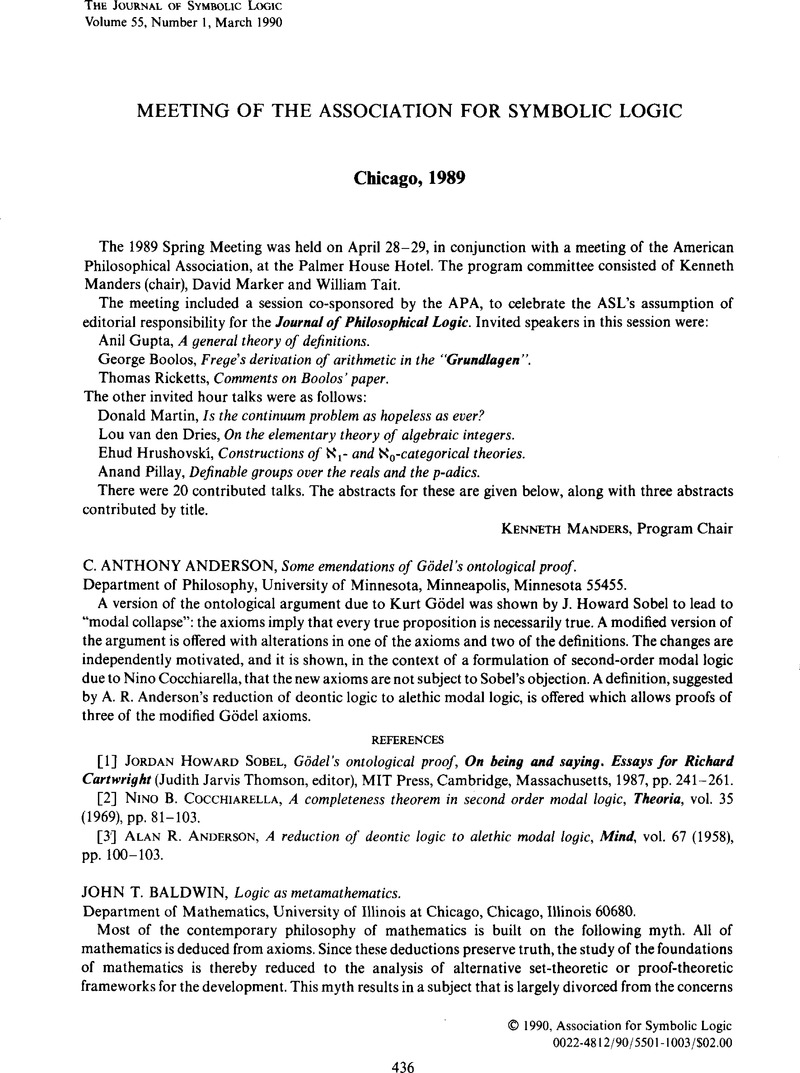No CrossRef data available.
Article contents
Meeting of the Association for Symbolic Logic, Chicago, 1989
Published online by Cambridge University Press: 12 March 2014
Abstract
An abstract is not available for this content so a preview has been provided. Please use the Get access link above for information on how to access this content.

- Type
- Other
- Information
- Copyright
- Copyright © Association for Symbolic Logic 1990
References
REFERENCES
[1]Sobel, Jordan Howard, Gödel's ontological proof, On being and saying. Essays for Richard Cartwright (Thomson, Judith Jarvis, editor), MIT Press, Cambridge, Massachusetts, 1987, pp. 241–261.Google Scholar
[2]Cocchiarella, Nino B., A completeness theorem in second order modal logic, Theoria, vol. 35 (1969), pp. 81–103.CrossRefGoogle Scholar
[3]Anderson, Alan R., A reduction of deontic logic to alethic modal logic, Mind, vol. 67 (1958), pp. 100–103.CrossRefGoogle Scholar
[1]Information processing systems—Concepts and terminology for the conceptual schema and the information base, Technical Report ISO/TR 9007, International Organization for Standardization, 1987.Google Scholar
[2]Lambek, J. and Scott, P. J., Introduction to higher order categorical logic, Cambridge University Press, Cambridge, 1986.Google Scholar
[1]Bostock, D., Necessary truth and a priori truth, Mind, vol. 97 (1988), pp. 343–379.CrossRefGoogle Scholar
[2]Deutsch, H., On direct reference, Themes from Kaplan (Almog, J.et al., editors), Oxford University Press, Oxford, 1988, pp. 167–195.Google Scholar
[3]Garson, J., Quantification in modal logic, Handbook of philosophical logic, vol. II (Gabbay, D. and Guenthner, F., editors), Reidel, Dorbrecht, 1984, pp. 249–307.CrossRefGoogle Scholar
[4]Zalta, Edward N., Logical and analytic truths that are not neccessary, The Journal of Philosophy, vol. 85 (1988), pp. 57–74.CrossRefGoogle Scholar
[2]Stalnaker, R., A theory of conditionals, Studies in logical theory (Rescher, N., editor), Blackwell, Oxford, 1968, pp. 98–112.Google Scholar
[3]Stalnaker, R., Indicative conditionals, Philosophia, vol. 5 (1975), pp. 269–286.CrossRefGoogle Scholar
[4]Thomason, R., A Fitch-style formulation of conditional logic, Logique et Analyse, vol. 52 (N.S. 13) (1970), pp. 397–412.Google Scholar
[P]Prest, Mike, Model theory and modules, London Mathematical Society Lecture Note Series, vol. 130, Cambridge University Press, London, 1988.CrossRefGoogle Scholar
[1]Aqvist, Lennart, Deontic logic, Handbook of philosophical logic (Gabbay, D. and Guenthner, F., editors), vol. II, Reidel, Dordrecht, 1984, pp. 605–714.CrossRefGoogle Scholar
[2]Hanson, William H., Semantics for deontic logic, Logique et Analyse, vol. 8 (1965), pp. 177–190.Google Scholar
Fraassen, Bas van [1968[, Presupposition, implication, and self-reference, The Journal of Philosophy, vol. 65, no. 5, pp. 136–152.CrossRefGoogle Scholar
Fraassen, Bas van [1970], Truth and paradoxical consequences, in Martin [1970A], pp. 13–32.Google Scholar
Kripke, Saul [1975], Outline of a theory of truth, The Journal of Philosophy, vol. 72, pp. 690–716; reprinted in Martin [1984], pp. 53–81.CrossRefGoogle Scholar
Martin, Robert L. [1970], A category solution to the Liar, Philosophical Review, vol. 76, pp. 279–311.CrossRefGoogle Scholar
Martin, Robert L. (editor) [1970A], The paradox of the Liar, Yale University Press, New Haven, Connecticut.Google Scholar
Martin, Robert L. (editor) [1984], Recent essays on truth and the Liar paradox, Oxford University Press, Oxford.Google Scholar
Martin, Robert L. and Woodruff, Peter W. [1975], On representing ‘True-in-L’ in L, Philosophia, vol. 5, pp. 213–217; reprinted in Martin [1984], pp. 47–51.CrossRefGoogle Scholar
Smullyan, Raymond [1957], Language in which self-reference is possible, this Journal, vol. 19, pp. 37–40.Google Scholar
[1]Bagemihl, F., The existence of an everywhere dense independent set, Michigan Mathematical Journal, vol. 20 (1973), pp. 1–2.CrossRefGoogle Scholar
[2]Gibbon, G., Set mappings of unrestricted order, Bulletin of the Australian Mathematical Society, vol. 28 (1983), pp. 199–206.CrossRefGoogle Scholar
[3]Newelski, L., Pawlikowski, J., and Seredyński, W., Infinite free set for small measure set mappings, Proceedings of the American Mathematical Society, vol. 100 (1987), pp. 335–339.CrossRefGoogle Scholar
[4]Piotrowski, Z. and Szymański, A., Some remarks on category in topological spaces, Proceedings of the American Mathematical Society, vol. 101 (1987), pp. 156–160.CrossRefGoogle Scholar
[1]Kaplansky, I., Infinite abelian groups, University of Michigan Press, Ann Arbor, Michigan, 1954.Google Scholar
[3]Rogers, H. Jr., Theory of recursive functions and effective computability, McGraw-Hill, New York, 1967.Google Scholar
[1]Freiling, Chris, Axioms of symmetry: throwing darts at the real number line, this Journal, vol. 51 (1986), pp. 190–200.Google Scholar
[2]Simms, John C., Traditional Cavalieri principles applied to the modern notion of area, Journal of Philosophical Logic (to appear).Google Scholar
[1]Schmerl, Ulf R., A fine structure generated by reflection formulas over primitive recursive arithmetic, Logic Colloquium '78, North-Holland, Amsterdam, 1979, pp. 335–350.Google Scholar
[1]Keisler, H. J., A survey of ultraproducts, Logic, methodology and philosophy of science (Bar-Hillel, Y., editor), North-Holland, Amsterdam, 1965, pp. 112–126.Google Scholar
Anellis, I. H., The Abian paradox, Abstracts of papers presented to the American Mathematical Society, vol. 9 (1988), p. 9; correction, I. H. Anellis, The Abian paradox, Abstracts of papers presented to the American Mathematical Society, vol. 9 (1988), p. 203.Google Scholar
[1]Cantor, G., Zur Begründung der transfiniten Mengenlehre. I, Mathematische Annalen, vol. 46 (1895), pp. 504–506.CrossRefGoogle Scholar
[2]Hausdorff, F., Grundzüge einer Theorie der geordneten Mengen, Mathematische Annalen, vol. 65 (1908), pp. 488–490.CrossRefGoogle Scholar
[3]Hausdorff, F., Grundzüge der Mengenlehre, Veit, Leipzig, 1914; reprint, Chelsea, New York, 1949, pp. 99–100 and 182–183.Google Scholar
[5]Huntington, E. V., The continuum as a type of order: an exposition of the modern theory, Annals of Mathematics, vol. 6 (1904/1905), pp. 178–179.Google Scholar


